| The Hanshinkan Kid (5): Haruki Murakami's attachment to Shukugawa |
||
| @@@ | ||
| Spring season in the city of Nishinomiya, Hyogo Prefecture, where I live. , the
Shukugawa river, a 10 or so minute walk from my house, was lined with gorgeous cherry blossoms in full glory. Paths along the river were
thronged with people enjoying the splendor of sakura. | ||
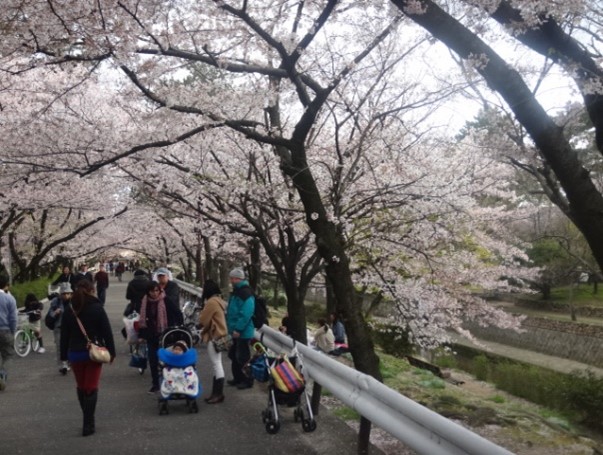 @ @ |
||
| The bank of Shukugawa river | ||
| The 7-kilometer Shukugawa river originates in the Rokko mountains and flows
from north to south, mainly through the southwestern parts of Nishinomiya. The river is about a 20-minute train ride from either Osaka or Kobe. Train stations close to the river include Hankyu Corp. fs Shukugawa Station and West Japan Railwayfs Sakura-Shukugawa Station. Shukugawa Park, a riverside park along the Shukugawa River, has been chosen as one of the 100 best cherry blossom viewing spots in Japan by the government-affiliated Cherry Blossom Association. | ||
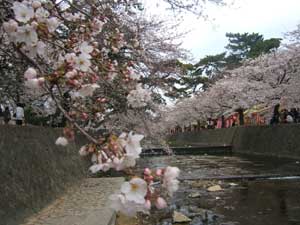 @ @ |
||
| The protagonist of acclaimed writer Haruki Murakamifs latest short story,
gYesterday,h published in the January 2014 issue of the Bungei Shunju monthly, is a man who hails from Ashiya, a city neighboring Nishinomiya.
His girlfriend used to live in Shukugawa. Murakami once described how he spent his boyhood years in areas between Osaka and Kobe as a so-called "Hanshinkan Kid." In his gHenkyo Kinkyo,h a collection of travel essays, he wrote, gI was born in Kyoto, according to the family register, but my family moved to a place named Shukugawa in the city of Nishinomiya, Hyogo Prefecture, soon after my birth and then moved again to the neighboring city of Ashiya, where I spent most of my teenage years.h There is a river named Shukugawa, but there is actually no city or town or any geographical area by that name. But many people living along the Shukugawa river have an attachment for the watercourse and often claim they live in Shukugawa. In surveys of people about the towns where they want to live in the Kansai region, areas around the Shukugawa river almost always are ranked high on the list. Thatfs probably because of the rich natural features they offer. Rows of cherry trees and the chirping of birds remind local residents of the changes in the seasons, while the river and areas along it serve as oases within urban areas. There is no other Murakami novel that refers to Shukugawa, but the writer describes the river and a stone bridge over it in his essay gRangeruhansu-to no Gogo" (Afternoon in the islets of Langerhans), published in 1986. | ||
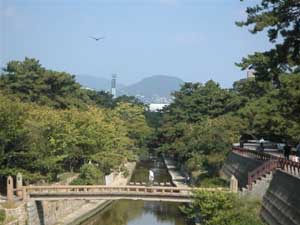 @ @ |
||
| The Ashiharabashi bridge | ||
| gA river runs between my house and the school. It is a river of clear water that is not so deep,
and there is a graceful old stone bridge over it.h In the photography section of gHenkyo Kinkyo,h Murakami wrote about his memories about the Shukugawa Oasis Road and the Ashihara Bashi bridge over the Shukugawa river. gI would cross the bridge frequently. This is the bridge that appeared in myeRangeruhansu-to no Gogo' (Afternoon in the islets of Langerhans). It is a lovely bridge. I heard that it would be soon taken down.h More than 20 years have passed since that time. But the bridge still crosses the river at the same place. It has been repaired instead of being taken down. RIVER CONNECTED TO GREAT WRITERS In addition to places remembered in connection with Murakami, there are also areas and locations along the Shukugawa river that are associated with other reputed Japanese writers who were actually, or presumably, candidates for the Nobel Prize in literature. During his boyhood years, Shusaku Endo lived near the Shukugawa Catholic Church and was baptized at the church. Endo is known to have played various pranks within the church. Junichiro Tanizaki moved from Yokohama to Kansai after the 1923 Great Kanto Earthquake, which flattened much of Tokyo and the surrounding areas. He lived in Kurakuen, a prime residential area along the upper reaches of the Shukugawa river. Four years after the earthquake, Tanizaki met with Matsuko Nezu, who later became his third and last wife. | ||
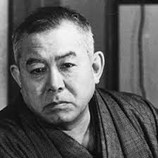 @ @ |
||
| Junichiro Tanizaki | ||
| Tanizaki began to live in the house of Matsukofs husband near Hankyufs Shukugawa Station even though
both were married to other spouses. Tanizaki described landscapes along the river in his major works such as gSasameyuki"
(The Makioka Sisters) and gManji.h Yasushi Inoue lived in Kawazoe-cho, a town along the lower reaches of the river, while he was working as a newspaper reporter. He later described what seemed to be townscapes along the river in his novels. Murakami also lived for a while in Kawazoe-cho, located on the eastern side of the river. Mao Danqing, a Chinese writer living in the city of Nishinomiya who is the editor in chief of the Chinese magazine Zhiri (Know Japan), said the Shukugawa is a ggigantic deviceh that produces great literary works. | ||
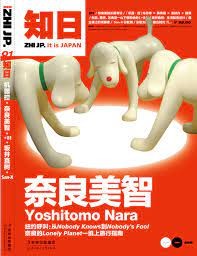 @ @ |
||
| gWhat with a river of clear water linking the mountains to the nearby sea and lines of trees in green tracts
of land on the banks of the river and what with the cosmopolitan city of Kobe, which is a door to the outside world,
located a short trip away, Shukugawa is an area that offers a good environment for literary creation,h Mao said. | ||
 @ @ |
||
| Clear water linking the mountains to the nearby sea | ||
|
MEMORIES OF INDIAN OLEANDERS Before long, the cherry blossoms along the Shukugawa river will fall, and the season of kyochikuto (Indian oleander) will arrive. Kyochikuto makes its appearance in Murakamifs works gRangeruhansu-to no Gogo,h gMekurayanagi to Nemuru Onna" (Blind willow, sleeping woman) and gNorwegian Wood.h Oleanders bloom from early summer until the end of fall, usually noticed or appreciated by few people. The sight of oleanders on the banks of the Shukugawa river showing off their gaudy pink blossoms under a blazing sun in summer remains seared in my memory. | ||
 @ @ |
||
| kyochikuto iIndian oleanderj | ||
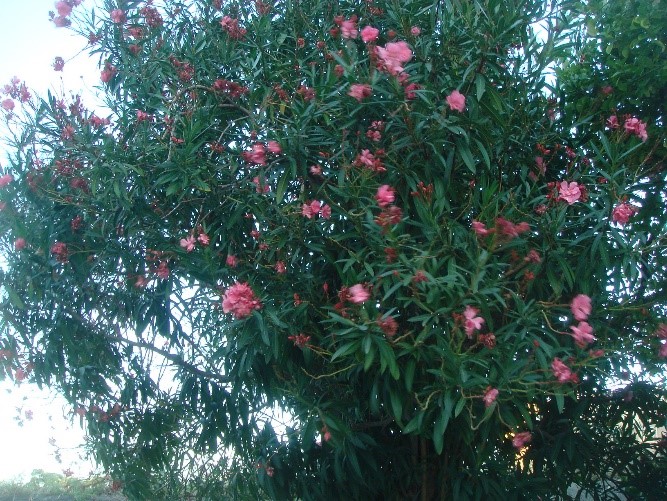 @ @ |
||
| When Murakami was a fourth-grader, a new Koroen Elementary School was built on the western side of the Shukugawa river.
He moved to the new school from a school on the eastern side of the river. When he was a sixth-grader, oleanders were planted in the schoolyard. The trees were transplanted from Nishinomiya Kaisei Hospital, which stands on the western bank at the riverfs mouth. All of the new schoolfs sixth-graders, including Murakami, dragged the trees with their roots attached from the hospital to the school. | ||
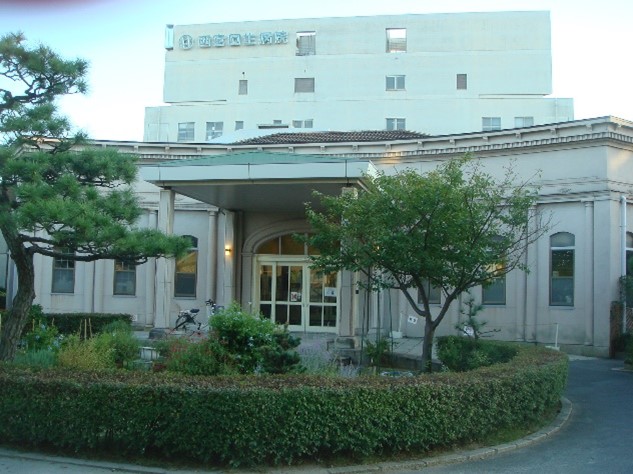 @ @ |
||
| Kaisei Hospital Old Building | ||
| gMekurayanagi to Nemuru Onna" was later combined with another short story
gFireflyh to develop into the huge hit gNorwegian Wood.h In this novel, a hospital reminiscent of Kaisei Hospital is described. @@@@@@@@@@@@ There are still many hospitals in uptown residential areas in the Hanshinkan region. But Kaisei Hospital is the only one standing on the coast. The hospital was a several-minute walk from either of the two houses in which Murakami lived in Shukugawa, the house on the western side or the one on the eastern side of the river. There is a path on the western bank of the Shukugawa river that only pedestrians and bicycles can travel through. I have dubbed the path the gshore of the islets of Langerhansh and regularly go for a walk along it. | ||
Copyright Since 2009 OFFICE ATSURO KAWAUCHI. All rights reserved.